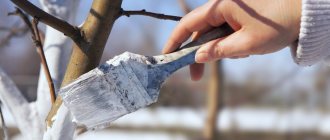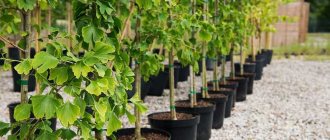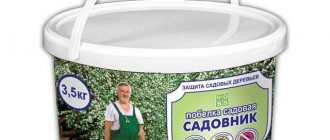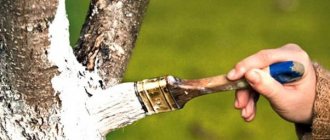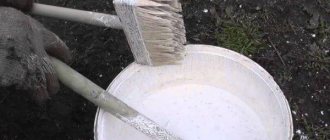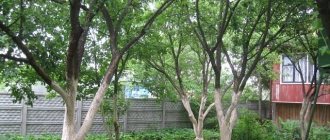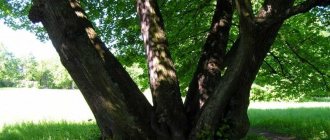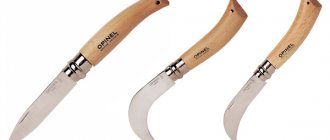One of the simplest and most popular agricultural practices for seasonal whitewashing of trees, year after year, a number of gardeners still raise the question of what to add to the whitewashing of trees to make it last longer?
Dear readers! For you, we have created communities on social networks in which useful articles and interesting ideas are published several times a day! Subscribe and receive useful content in a convenient format!
On the one hand, today many folk methods have been tested, there are dozens of offers of ready-made mixtures sold in stores.
But what to choose from all the variety specifically for your situation, and what to use in the specific conditions of the region and at a certain time of the year - here it is better to thoroughly know the features of all whitewash options in order to act with confidence.
What do you usually use to whiten trees?
Whitewashing trees is an important agrotechnical technique, the main task of which is to protect trees.
First of all, the treated tree is not afraid of sunburn on the bark, and can develop better throughout the warm season.
Secondly, whitewash serves as an additional protective layer from temperature changes. That is why, under ideal conditions, trees are whitened in early spring and/or late autumn - first to protect them from heat and then from severe frosts.
Finally, whitewash applied in a thick layer effectively prevents the spread of fungi and other plant diseases on the bark. And if you add something to the product, the whitewash will last longer and additionally repel insect pests, even some rodents.
Moreover, the most common and at the same time simplest ways to whiten trees is to prepare a solution of slaked lime or dilute a chalk-based product.
However, there are a large number of other folk techniques or ready-made purchased products, where in addition to whitewashing, the composition contains adhesives, insecticidal or fungicidal preparations - all so that simple whitewashing of trees at the same time, in addition to the protective function, additionally solves the problem of useful, effective, feeding processing.
Water-based
Very effective protection against sudden changes in air temperature and in too bright sunlight. Most water-based paints are based on acrylic resins, which protect trees from rotting and the spread of various types of bacteria. However, acrylic paints do not protect against pests, so it is recommended to add special substances containing copper to ready-made solutions. You should only choose acrylic paint marked “for garden trees.” Must be applied in warm, windless weather.
How to properly prepare a classic solution for whitewashing trees
Only two types of tree whitening are most common:
- slaked lime;
- chalk.
When lime is used, the result is a white mixture that perfectly reflects the sun's rays, which is very necessary in the very early spring, when the trees have not yet developed leaves.
Slaked lime has proven itself very well, primarily in protecting tree bark from burns.
But when using only lime, it is impossible to prepare whitewash so that it lasts longer. Even just the first couple of rains washes it off quite easily.
Approximately the same properties are characteristic of the second most popular method of applying whitewash - diluting chalk in water. In this case, a bright white color is achieved, which does not attract the sun's rays as much, but the paint is also washed off quite easily and quickly.
The advantage of chalk whitewash for trees will undoubtedly be that it is not at all harmful to humans and plants than that prepared on the basis of lime.
Water-dispersed
The composition of the liquid mixture is unique. Here are present:
- antiseptics (protect tree trunks from pests);
- white pigment (prevents destructive processes occurring as a result of ultraviolet irradiation);
- latex (provides durability and long-lasting coverage).
An important component of the product must be acrylic, which will prevent the paint from being washed off under the influence of precipitation.
This type of product repels rodents and insects, so no additional components should be added to it.
There are several common varieties of this garden paint for trees. “Luck” is one of them. It is easy to use and safe for any type of plant, even the youngest.
The next type of acrylic water-dispersed garden paint for trees is “Ecosil”. Garden emulsion improves the frost resistance of plants. In some cases, it can serve as a growth stimulator for garden trees and shrubs.
What to add to the whitewash composition to make the paint last longer
Accordingly, gardeners use a variety of tricks, adding various additional ingredients to the whitewash for trees so that the paint lasts longer or performs some other related functions.
Clay
Clay with slaked lime or chalk increases paint resistance to natural precipitation. But the method also has more serious advantages.
Firstly, you can simply use white or yellow clay without mixing it with anything, applying it to the bark up to the first branches.
Secondly, mixtures with added clay or simply applied clay are noticeably more viscous compared to ordinary lime or chalk, which means they “fit” better on the tree bark, literally sticking. This product is easier to apply, and when it hardens, it lasts longer in the garden.
The clay, in parallel, tightly seals cracks and any damage to the bark. They are also known to be the main gates for the penetration of infections into cultivated plants. The unevenness of the bark is also a real paradise for various pests and their larvae. A product containing clay will not allow them to live and reproduce in peace.
Fungicidal preparations
Quite often, gardeners resort to simultaneously whitewashing plant trunks and preventing fungal diseases. Various fungicidal additives help in this matter.
Probably the simplest option is copper sulfate. It is cheap and accessible; it is often added even to purchased whitewash mixtures, since there is no doubt about the effectiveness of the product.
Whitewashing trees using fungicides in itself helps in preventing the development of a wide variety of fungi and infections, but it can also serve as one of the stages of additional treatment of the garden after the main spring dressing.
BY THE WAY. An alternative to copper sulfate can be Bordeaux mixture, iron sulfate or commercial fungicide "Hom". When adding products, it is important to use the recommended dosages.
Milk and dairy products
If you add milk or, for example, whey to the whitewash for trees to make it last longer, then it will also “stick” relatively well to the bark of the trees. Also, a solution with milk will to some extent feed the plants with useful minerals. According to some reports, some pathogenic microflora are suppressed.
Carbolic acid
Another “trick” of some gardeners can be considered the addition of carbolic acid to slaked lime or chalk in whitewashing trees. In addition to the fact that lime and chalk repel rodent pests - mice and hares - the addition of acid enhances the effect. Animals are reluctant to approach treated trees and damage the bark because they cannot stand the smell of carbolic acid.
Preparing for painting
Before applying paint, you should carefully prepare the tree bark. What needs to be done for this?
First of all, it is recommended to clean the surface of the bark from dust and dirt, as well as scrape off moss and all kinds of lichens. This can be done using a wire brush or scraper. It is recommended to collect and burn the peeled bark that falls down, as it may contain sleeping larvae or eggs of pests.
As a universal preventive measure, or if the tree has damage and cracks, the bark should be treated with garden varnish. It is also possible to impregnate the bark with alkaline agents to destroy possible microbes and parasites located in the trunk.
After such manipulations, the surface of the wood must completely dry, and only then will it be necessary to whitewash it.
What to add so that the whitewash does not wash off when it rains?
Ordinary slaked lime, chalk, and other classic methods of whitewashing trees seem simple, but it is obvious that they are far from the most durable. Often it only takes one or two rains, and all the work is washed away almost completely.
That is why, so that the whitewash does not wash off during rain, additional ingredients should be added to classic recipes.
Glue
Perhaps the most effective and therefore very popular additive for whitewashing trees so that it does not wash away in the rain is glue. Moreover, in gardening, different types of glue are equally widely used: carpentry, wallpaper, casein. Less common is PVA, since although it is very accessible, easy to use and economical, it is still less well tolerated by plants. In particular, it is harder for trees to breathe under a layer of whitewash with the addition of PVA glue.
But in general, whitewashing with glue is very captivating due to its main qualities: it lasts a long time, does little harm to trees, but at the same time does not allow moisture to penetrate the pores of the bark and destroy it.
Soap
Soap solutions are generally widely used for various popular spray mixtures in the garden, since they also allow the treatment to “stick” to the plants noticeably longer. The easiest way is to add ordinary laundry soap, which is pre-grated and thoroughly mixed with the whitewash until completely dissolved.
However, there are recipes that require the use of standard store-bought soap - they say that it also copes well with pests and plant diseases. In general, you can do either way, depending on the situation and personal preferences.
Manure
Several “hares” can be killed at once by adding manure to the whitewash (mullein is most often used). In this case, the whitewash becomes more sticky, adheres better to the bark and holds more securely.
Secondly, manure has good antiseptic properties, tightly fills pores and affected areas, and helps in the fight against diseases and pests.
Finally, the obvious properties of manure are feeding plants. So in the garden, not only the necessary seasonal whitening of trees is carried out, but also at the same time the regular application of fertilizers.
Means for disinfecting damaged areas
Chemical (Their supporters claim that other methods cannot achieve a good effect. Opponents say that if such mixtures are constantly used, they accumulate both in the soil and in the plant itself, and as a result have a detrimental effect on it):
- Iron sulfate, or rather its solution. To prepare the correct composition, you need to take the following proportion as a basis: for ten liters of water we take half a kilogram of the substance.
- Compositions with copper. If you are interested in pre- whitening trees with copper sulfate , then when diluting the mixture, use the same scheme as in the previous case.
- Powdered fungicides, quite potent, such as hom, phytosporin. When diluting, take very little, 30-40 grams for the same 10 liters of water will be quite enough.
- Oksikhom. Has broader abilities, unlike its counterpart. Therefore, it is worth reducing the dose of the substance by half, i.e. We take only 20 grams.
Natural:
- Infusion of ash. In order to knead it, you need ten liters of boiling water, into which you need to pour about 3 kilograms of ash, but do not forget to sift it first. This whole mixture will not stick to the surface of the wood unless a binder is added to it.
Regular laundry soap acts as glue. You won't need about a quarter of a standard briquette of 200 grams. After everything is ready, do not put off the work; you need to apply the mixture before it cools down.
- If you don’t want to bother with applying medications, you can use a sprayer. To do this, you should make ash liquor. We take water and ash in the same proportions as described above, combine and put on fire. When all this boils, the liquid we need is formed, and we use it for irrigation.
After such treatment, original patches need to be made on large open areas of plant tissue. This is protection from various kinds of dangers, and from premature and too rapid loss of moisture.
Garden pitch is the most favorite putty of gardeners. You can buy it in a store or make it yourself. If there are different alternative options. Garden stores offer various pastes, they are ready-made, you don’t need to mix or add anything.
how to properly carry out such a process as whitewashing garden trees :
- Do not try to spread the mixture with lime too much; a thin layer does not mean a good one. It should be quite dense, but not thick. If you use paint, you can apply a thinner composition.
- No precipitation. Keep an eye on the weather forecast; apply the solution on a dry day without rain. When it comes to applying paint, the temperature is also important, at least +3.
- Under no circumstances use anything you could find in your own basement for such a task. Whatever paint is not suitable, it may do more harm than good. Go to the store and look on the shelf for a product marked “ paint for whitewashing trees .”
Now another important point - how high should the whitewash layer reach? You have probably already noticed that the plants on city streets have very low “white skirts”. According to the standard, they are whitened to about a meter in height. Maximum – 1.20 m. And this is completely wrong. Such a modest “outfit” is not capable of protecting from frost.
If possible, apply the composition as high as possible. For an already strong plant, this is at least one and a half meters. Those. You must capture the entire trunk and a third of the thick branches, they are also called skeletal.
By the way, do not forget that you need to whiten not only as high as possible, but also as low as possible. Within reasonable limits. Before you begin, rake the soil around the base of the trunk a little to get the brush over it. And then return the soil to its place. The main thing is not to overdo it with depth. Otherwise, instead of doing good, you will cause harm.
Trees should be painted as close to the ground as possible and at least to the skeletal branches.
Whitewashing recipes for trees
Based on the fact that there are a lot of additives in whitewashing trees, we can identify several ready-made recipes for preparing the solution.
- To make the solution last longer, add about 2.5 kg of slaked lime, no more than 200 g of wood glue for every 10 liters of clean water. If desired, add about 500 g of copper sulfate.
- A solution of 10 liters of water, plus the addition of 2.5 kg of lime, 1 kg of clay and 1 shovel of manure, is very popular. Also, if desired, you can add no more than 200-300 g of copper sulfate.
- Another option for making tree whitewash last longer: up to 2 kg of chalk per 10-liter bucket of water and add about 10 tbsp. spoons of flour paste as a fixative for the mixture.
- One of the most versatile and effective solutions consists of 10 liters of clean water, 2 kg of lime or chalk, 1 shovel of manure, 500 g of copper sulfate, shavings from about half a standard piece of laundry soap and a tablespoon of carbolic acid.
- Take 1 liter of milk (dairy products), dilute it in 9 liters of clean water, mix another 2.5 kg of lime and 1 kg of clay, add any soap as a fixative.
When preparing a solution for whitewashing trees, in order for it to last longer, it is important to thoroughly mix all the ingredients to a uniform consistency. The fewer lumps left, the better it will be possible to whiten the trees, the denser the solution will lie on the bark, the less chance it will be quickly washed away by rain.
Gardening Tips and Tricks
Of course, such a popular garden procedure as whitewashing trees in the fall or spring is characterized by quite a few subtleties and tricks. Because a lot of people whitewash trees. And everyone often comes up with their own “tricks”.
- Classic whitewashing involves processing the tree trunk from the root collar to the first so-called “skeletal” branches - this is a strict rule.
- When using classic slaked lime for whitewashing, do not forget about personal protective equipment (goggles and gloves), since when lime reacts with water, the temperature of the mixture can rise above +70°C.
- If young trees are whitewashed, then all additional additives should be reduced by approximately 2 times so as not to harm the plants.
- In order for copper sulfate to completely dissolve and help better, it is first diluted in a small amount of warm water, and only then added to the general solution.
- There is no single application rate for trees: all plants differ in size. The main thing is not to skip areas, work from the ground to the branches and paint the bark with a thick layer of solution.
Otherwise, whitewashing trees in spring or autumn is a fairly simple and understandable task. There is nothing supernatural about it. Surely, even as you gain experience, you yourself will not notice how you will begin to whitewash better and better, since you will intuitively understand how to apply whitewash more conveniently, easier and faster.
Processing technology
It is not enough to know how to slak lime for whitewashing trees and how to prepare solutions for this. You need to be able to conduct thorough preparations for a responsible event. Experienced gardeners first walk around their property and carefully study the condition of the fruit-bearing trunks and the lower third of the skeletal branches, clearing them of dead bark. To do this, they spread a large old rag under the tree, and then with a wooden (not metal) scraper they very carefully tear off what easily comes off the trunk. Trees tolerate this operation more easily if it is performed in cloudy weather. Any remaining bark that has fallen onto a rag must be burned. Pests may remain in it.
Stripping dead bark Source i.ytimg.com
Answers to frequently asked questions
Is there a difference when to whitewash trees, in the fall or in the spring?
It is enough to protect the trees with whitewash once. In spring or autumn - it is decided by the gardener himself. Whatever is more convenient. Some whitewash trees twice a year.
What is better - to renew the whitewash of trees several times or to add additional products to the composition?
Also at the discretion of the garden owner. You can give preference to purchased whitewashes, which contain several substances at once. They are both useful and at the same time last longer on the bark.
Do trees really need whitewashing?
Not that this is an urgent need. But whitewashing, firstly, is a very simple agricultural technique. Secondly, it has proven itself to be good in terms of efficiency.
Manure
Astringent-adhesive properties are also found in manure. Its inclusion in whitewashing in a normalized proportion makes the whitewash not so snow-white, but it quickly sticks to the gnarled surface of tree trunks.
In addition, manure is believed to have antiseptic properties, which, as a result of whitewashing tree trunks with it, leads to both disinfection and foliar feeding of the garden. Many gardeners certainly introduce this useful organic matter (manure) into homemade whitewash compositions and are satisfied with both the appearance of the trunks and the result of such whitewashing both in the fall and in the spring.
